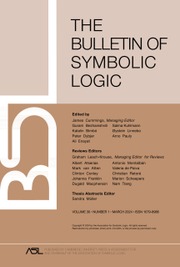No CrossRef data available.
Article contents
FEFERMAN’S COMPLETENESS THEOREM
Published online by Cambridge University Press: 10 January 2025
Abstract
Feferman proved in 1962 [6] that any arithmetical theorem is a consequence of a suitable transfinite iteration of full uniform reflection of  $\mathsf {PA}$. This result is commonly known as Feferman’s completeness theorem. The purpose of this paper is twofold. On the one hand this is an expository paper, giving two new proofs of Feferman’s completeness theorem that, we hope, shed light on this mysterious and often overlooked result. On the other hand, we combine one of our proofs with results from computable structure theory due to Ash and Knight to give sharp bounds on the order types of well-orders necessary to attain the completeness for levels of the arithmetical hierarchy.
$\mathsf {PA}$. This result is commonly known as Feferman’s completeness theorem. The purpose of this paper is twofold. On the one hand this is an expository paper, giving two new proofs of Feferman’s completeness theorem that, we hope, shed light on this mysterious and often overlooked result. On the other hand, we combine one of our proofs with results from computable structure theory due to Ash and Knight to give sharp bounds on the order types of well-orders necessary to attain the completeness for levels of the arithmetical hierarchy.
Information
- Type
- Article
- Information
- Copyright
- © The Author(s), 2025. Published by Cambridge University Press on behalf of The Association for Symbolic Logic


